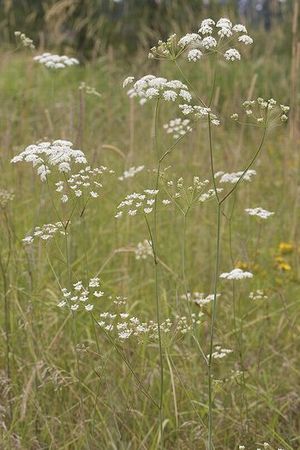Difference between revisions of "Perideridia montana"
| Line 1: | Line 1: | ||
| − | + | [[File:Pega.jpeg|thumb|right|300px| ''Perideridia gairdneri'' <br/> Photo Credit Robert Gilbert]] | |
''Perideridia gairdneri,'' also called Gairdner's yampah, common yampah, or Gardner's yampah is a flowering plant in the Apiaceae family. | ''Perideridia gairdneri,'' also called Gairdner's yampah, common yampah, or Gardner's yampah is a flowering plant in the Apiaceae family. | ||
Revision as of 10:15, 30 April 2012
Perideridia gairdneri, also called Gairdner's yampah, common yampah, or Gardner's yampah is a flowering plant in the Apiaceae family.
Contents
Taxonomy
- Kingdom - Plantae – Plants
- Subkingdom - Tracheobionta – Vascular plants
- Superdivision - Spermatophyta – Seed plants
- Division - Magnoliophyta – Flowering plants
- Class -Magnoliopsida – Dicotyledons
- Subclass - Rosidae
- Order - Apiales
- Family - Apiaceae – Carrot family
- Genus - Perideridia
- Species - P. gairdneri
Description
P. gairdneri is a thick, tuberous rooted perennial herb that is slender and hairless. It has solitary, leafy stems, and grows from 40 - 120 cm tall. It has several, well distributed leaves that are once or two times pinnately divided into long, narrow segments. Flowers are white or pink and small, and are united in groups to form one to several compound umbels. Fruits are nearly spherical and slightly flattened, with distinct ribs. Fruits 2 - 3 mm long.
Source: Pojar pg 221
Bloom Period
July to August Source: http://biology.burke.washington.edu/herbarium/imagecollection.php
Distribution
Occurs from British Columbia to Saskatchewan, south across the Rockies and West Coast, down to Southern California.
Source: http://plants.usda.gov/java/profile?symbol=PEGA3
Habitat
Dry to vernally moist open forest, meadow, or grassy slope. Low to middle elevation.
Source: Pojar 221
Uses
Roots of P. gairdneri were eaten my Straits Salish and other First Peoples groups of the Northwest, and by interior peoples from south central British Columbia, to the great basin. The roots were pounded by native people to make flour.
Source: Pojar pg 221
Propagation
Photo Gallery
http://biology.burke.washington.edu/herbarium/imagecollection.php

